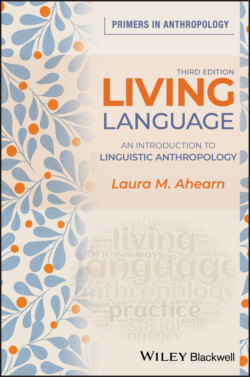Читать книгу Living Language - Laura M. Ahearn - Страница 33
2
Gestures, Sign Languages, and Multimodality
ОглавлениеHaving introduced readers to linguistic anthropologists’ approach to language as a form of social action, we discuss in this chapter how language is much more than just talk or words. As Jakobson’s concept of multifunctionality emphasizes, linguistic interactions are always operating on multiple levels and through multiple channels. Scholars call this multimodality, and those who study multimodal discourse seek to understand more deeply how participants in an interaction can co-construct meanings through multiple modes (which can also be called modalities or channels) in addition to face-to-face speech, such as nonverbal gestures, gazes, facial expressions, body movements, written texts, computers, material objects, or other semiotic forms.
Consider the following example. In a classic comedy skit that appeared on “The Tonight Show” in 2013, entitled, “#Hashtag,” Jimmy Fallon and Justin Timberlake proceed to have a face-to-face conversation that mimics an online exchange.1 Throughout the interaction they liberally intersperse the word “hashtag,” accompanying it with a hand gesture – two fingers of each hand overlapping each other to look like the number sign on a keyboard – whenever an online user might insert a hashtag in a post on social media. Their rapid-fire references to American popular culture are very generation- and culture-specific, so many of the jokes might be unintelligible to some audiences, but for our purposes the interesting point is that the comedy routine derives much of its humor from the central idea of the skit: the displacement of a linguistic feature (the hashtag) from one mode of communication (social media), where it is ordinarily used, to another (face-to-face conversation). Different modes of communication often involve different socially and culturally specific conventions of language use, and individuals who transgress those conventions may generate laughter, anger, or confusion.2 The humor in this skit derives, at least partially, from this sort of transgression.
The “#Hashtag” skit is also a useful example in several other respects because it demonstrates how meanings can be co-constructed by participants not just through speech but through various other semiotic modes, or channels. Hearkening back to Jakobson’s model representing the multifunctionality of language (see Figure 1.4 from Chapter 1), we might recall that one of the prime constituents of a speech event is the “channel,” or mode, through which the interaction takes place. If we broaden our analysis beyond interactions that involve face-to-face conversation, it soon becomes clear that semiosis – or meaning making – can occur through many modes, including, for example, the following (among others):
Speech
Gestures and other forms of embodied communication
Sign languages
Whistles
Song
Illustrations and images
Writing
Often, particular uses of language will involve more than one of these modes. Instances involving what linguistic anthropologists call multimodal discourse are more common than you might imagine; any time a person’s speech is accompanied by gestures or body movements, for example, the interaction is multimodal. Before focusing in on some of these nonverbal modes of meaning-making, however, it will be helpful to present the work of two scholars, Erving Goffman and Mikhail Bakhtin, each of whom mainly worked on verbal interactions, but their theories are still quite applicable to understanding the multimodality inherent in human communication.
